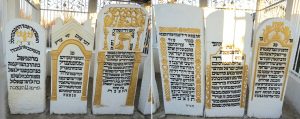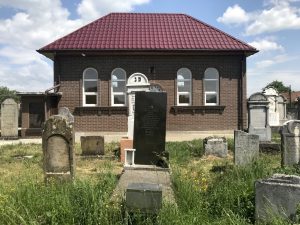![]() Ця сторінка також доступна українською.
Ця сторінка також доступна українською.
Introduction
This page summarizes and analyzes a project which reconstructed an ohel over the graves of renowned tzadikim and their families in the Jewish cemetery of Zabolotiv in the Sniatyn raion of the Ivano-Frankivsk oblast in western Ukraine. A brief history of the rabbinical dynasty in Zabolotiv plus photographs of the completed ohel and its matzevot have been published online for free public access by the organization which funded and organized the project. This project coordinates indirectly with other projects managed by the same and other organizations at the same site.
This page is intended as a reference for similar projects now in the planning stages in western Ukraine or beyond. Following a brief summary of the site, the material below describes the project and reviews its effectiveness together with a listing of issues encountered, approximate project costs, and ongoing risks. Related projects both in western Ukraine and elsewhere in Europe are also briefly mentioned, for comparison. At the bottom of this page are links to project documentation and to additional reference information about the burial site and related projects.
Read the overview to case studies of selected projects at Jewish burial sites in western Ukraine.
Project Summary
Project type: Full ohel reconstruction within the Jewish cemetery, enclosing the graves of known tzadikim and their families, plus cleaning and painting of the matzevot.
Location and site type: Jewish cemetery of Zabolotiv, Sniatyn raion, Ivano-Frankivsk oblast, Ukraine. GPS: 48.46935 25.28849.
Description of the site: The cemetery perimeter is an irregular shape of approximately 420m length, enclosing roughly 0.75 hectares of area, on a partially wooded, flat terrain. The ohel is near the southern perimeter of the main section of the cemetery.
Ownership and stakeholders: The cemetery site is owned by the municipality of Zabolotiv. Stakeholders include the local civil community, foreign descendants of Zabolotiv pre-war Jewish and other families, historians, and students of Jewish culture; the graves of the tzadikim are of particular importance to their descendants and to followers of their Hasidic dynasty.
Official heritage status: Unknown.
Activists working on/at the site: Geder Avos Jewish Heritage Group, a non-profit Jewish heritage organization founded in New York, USA by the World – Center of European Rabbis (WCER), coordinated funding and communication for the project. Contact info and webform. Their partner Oholei Tzadikim managed the reconstruction and painting project at the cemetery site.
Other projects active at the site: Digital documentation of the cemetery terrain (see ESJF 2019 project); digital documentation of headstone images (see CJA 1994 project); digital documentation of previous ohel (see CJA 2010 project); vegetation clearing and perimeter fence construction (in coordination with Geder Avos; see ESJF 2017 project).
Project Analysis
History of the site: Research and a 1996 survey by Yuriy Isaakovich Khodorkovskiy for the US Commission (now IAJGS International Jewish Cemetery Project) indicates that the cemetery was probably established by the Jewish community before the 18th century; surveying the surviving matzevot for dates in past decades has not been possible due to excess vegetation. The IAJGS report also records that the cemetery perimeter was encroached after WWII by housing development.
Current features of/at the site: Some headstones were removed during and/or after WWII, however at least several hundred headstones remain, mostly in original locations though some are now significantly tilted; in the 1996 survey, some headstones retained traces of colored paint. Private residences and gardens border the cemetery along all sides, with a wooded section at the east side and a football field at the northeast corner. Large trees and heavy shrubs grow at several locations of the cemetery. A full perimeter fence and gate was erected by ESJF in 2017. There is no informational signage.
An open-frame ohel was built over the graves of tzadikim of the Hager family at the southern end of the cemetery in the 1990s and documented by CJA in 2010; reconstruction of that ohel in 2018 is the subject of this case study.
Details of the project: The project began with inspection of the existing ohel structure and its environment and the condition of the protected matzevot, plus planning and notification of the local municipal authorities. The ground around the ohel was cleared, including removal of a large tree adjacent to one side, which hung over and pressed against the ohel roof. Reconstruction included a new concrete foundation around and under the ohel; extension of the upper portion of the support columns, a new metal roof; complete replacement of the steel bar infill and wrought iron and decorative lacework panels and gate; and new protective painting of the entire structure. In addition, the matzevot of the tzadikim and their family members were cleaned and coated with new paint in white, black, and gold colors. A new gravel path between the cemetery gate and the ohel gate was laid down to control vegetation and ease access for visitors.
Issues encountered in the project: There were no unusual issues in reconstructing the ohel.
Project costs, one-time and sustaining: The overall survey, design, cleaning, reconstruction, and administrative costs for this project totaled approximately US$10,000.
Current risks to preservation: The earlier vegetation clearing and fencing projects have improved protection of the site and reduced gradual damage to the ohel and to headstones in the rest of the cemetery, but past experience at the site suggests that the rapid growth of wild vegetation will be a recurring concern. The IAJGS survey of 1996 indicated that some vegetation growth was previously controlled by grazing animals, which are now excluded from the cemetery by the fence. Otherwise ordinary vandalism and natural decay of the built features, including in the ohel, should be reduced.
Related projects in western Ukraine: Geder Avos and Oholei Tzadikim have cooperated on the construction or reconstruction of ohels in more than ten cemeteries in western Ukraine, including at Kosiv, Kuty, and Pechenizhyn in Ivano-Frankivsk oblast, at Yahilnytsia and Kozova in Ternopil oblast, at Sambir in Lviv oblast, at Vyzhnytsia in Chernivtsi oblast, and at Khust in Zakarpattia oblast. Oholei Tzadikim has independently constructed ohels in other cemeteries in the region, including at Rohatyn in Ivano-Frankivsk oblast. The Faina Petryakova Scientific Center for Judaica and Jewish Art has organized and constructed ohels in cemeteries including at Novi Strilyshcha in Lviv oblast and at Stratyn in Ivano-Frankivsk oblast.
Related projects outside western Ukraine: Together Geder Avos and Oholei Tzadikim have constructed ohels across Ukraine, including at Ostroh (Rivne oblast), Mohyliv-Podilskyi (Vinnytsia oblast), and Medzhybizh (Khmelnytskyi oblast). Geder Avos has coordinated ohel projects in other countries as well, including at Siret (Romania), Niepołomice (Poland), and Tachov (Czech Republic).
References
- Zablotov, Ukraine – ohel reconstruction project summary by Geder Avos
- Zabolotiv Jewish Cemetery – terrain measurements and survey notes by ESJF European Jewish Cemeteries Initiative
- Zabolotiv – the cemetery research and survey page on the website of the IAJGS International Jewish Cemetery Project
- Zabolotiv – the Jewish cemetery fencing project data and images by ESJF European Jewish Cemeteries Initiative
- Jewish cemetery in Zabolotiv – the 1994 cemetery photographs and documentation page in the web database of the Center for Jewish Art
- Ohel in the Jewish cemetery in Zabolotiv – the 2010 ohel photographs and documentation page in the web database of the Center for Jewish Art
- Zabolotiv Jewish Cemetery – the cemetery research and survey page in the web database of Lo Tishkach European Jewish Cemeteries Initiative





